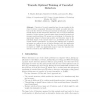Free Online Productivity Tools
i2Speak
i2Symbol
i2OCR
iTex2Img
iWeb2Print
iWeb2Shot
i2Type
iPdf2Split
iPdf2Merge
i2Bopomofo
i2Arabic
i2Style
i2Image
i2PDF
iLatex2Rtf
Sci2ools
126
Voted
ECCV
2006
Springer
2006
Springer
Towards Optimal Training of Cascaded Detectors
Cascades of boosted ensembles have become popular in the object detection community following their highly successful introduction in the face detector of Viola and Jones [1]. In this paper, we explore several aspects of this architecture that have not yet received adequate attention: decision points of cascade stages, faster ensemble learning, and stronger weak hypotheses. We present a novel strategy to determine the appropriate balance between false positive and detection rates in the individual stages of the cascade based on a probablistic model of the overall cascade's performance. To improve the training time of individual stages, we explore the use of feature filtering before the application of Adaboost. Finally, we show that the use of stronger weak hypotheses based on CART can significantly improve upon the standard face detection results on the CMU-MIT data set.
Cascade Stages | Computer Vision | ECCV 2006 | Individual Stages | Object Detection Community | Standard Face Detection | Stronger Weak Hypotheses |
| Added | 16 Oct 2009 |
| Updated | 16 Oct 2009 |
| Type | Conference |
| Year | 2006 |
| Where | ECCV |
| Authors | S. Charles Brubaker, Matthew D. Mullin, James M. Rehg |
Comments (0)

